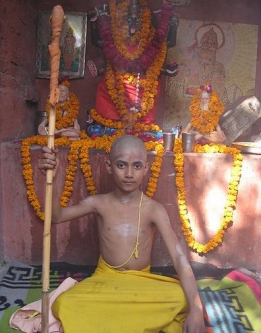Hinduism: Rites of Initiation | 14
Rites of Initiation
Two factors are important to note in discussing life-cycle rites:
First, not all are pan-Hindu, and even those that are may have little importance in some communities.
Second, many of the important rites, especially those that are celebrated for girls or women, may not be discussed in any classical text on dharma:
This is possibly because many of the texts were written by men. Women were treated as the partners of males, who were the main focus of the books. It may also be that some of these rites emerged after these texts were written.
Many life-cycle rituals are called auspicious. The English word “auspiciousness” has been used as a shorthand term for a rather wide category of features in Hindu life. Auspicious times are chosen for the conduct of all sacraments; these times are in agreement with the person’s horoscope.
A person’s sacraments (saṁskāras; literally “perfecting”) begin prenatally:
Two of these, called pumsavana (seeking a male offspring) and simanta (hair parting), are followed by many communities in India:
Although formerly performed in the 5th month of pregnancy, they are done much later now for the safe birth of a child, preferably a male.
After childbirth a ceremony called jātakarma (birth ceremony) is performed. In earlier days this was supposed to be done before the umbilical cord was cut, but it is now done much later.
The moment of birth is also noted, so that the exact horoscope of the child can be charted.
Childhood sacraments include naming, the first feeding of solid food, tonsure or cutting of the child’s hair, and piercing of the ears (which was historically done for both boys and girls but now only applies to girls).
The beginning of education for a child is called vidyā āraṁbhaḥ (literally “the beginning of learning”).
The ritual that initiates a young Brahman boy into the study of the Vedas is called Upanayana or Brahma Upadeśa.
The word Upanayana has 2 meanings: it may mean “acquiring the extra eye of knowledge” or “coming close to a teacher” to get knowledge.
Brahma Upadeśa means receiving the sacred teaching (Upadeśa) concerning the Supreme Being (Brahman).
The ritual of Upanayana traditionally initiates a young boy at about age 8 into the first stage of life, called brahmacārya. This word literally means “traveling on the path that will disclose the Supreme Being,” that is, studenthood.
The central part of the ritual is the imparting of the sacred teaching:
As the boy sits with his father and the priest under a silk cloth (symbolizing the spiritual womb, according to some), a sacred mantra (sentence for chanting) is given to him:
He is to repeat this mantra 108 times, 3 times a day. The mantra, known as the Gāyatrī, is short: “I meditate on the brilliance of the sun; may it illumine my mind.”
In Vedic times, and possibly even well into the first millennium of this era, the young boy began his Vedic studies at this stage and went to live with his new teacher for several years.
The ceremony is now conducted with considerable social overtones in many communities.
Traditionally, male members of the upper three classes went through this ritual, but it is now performed mainly by the Brāhmanic sections of the Hindu community.
The auspicious marriage is a way to fulfil obligations to society:
According to the Dharma Śāstra texts, a wife is a man’s partner in fulfilling dharma, and without her a man cannot fully perform his religious obligations.
